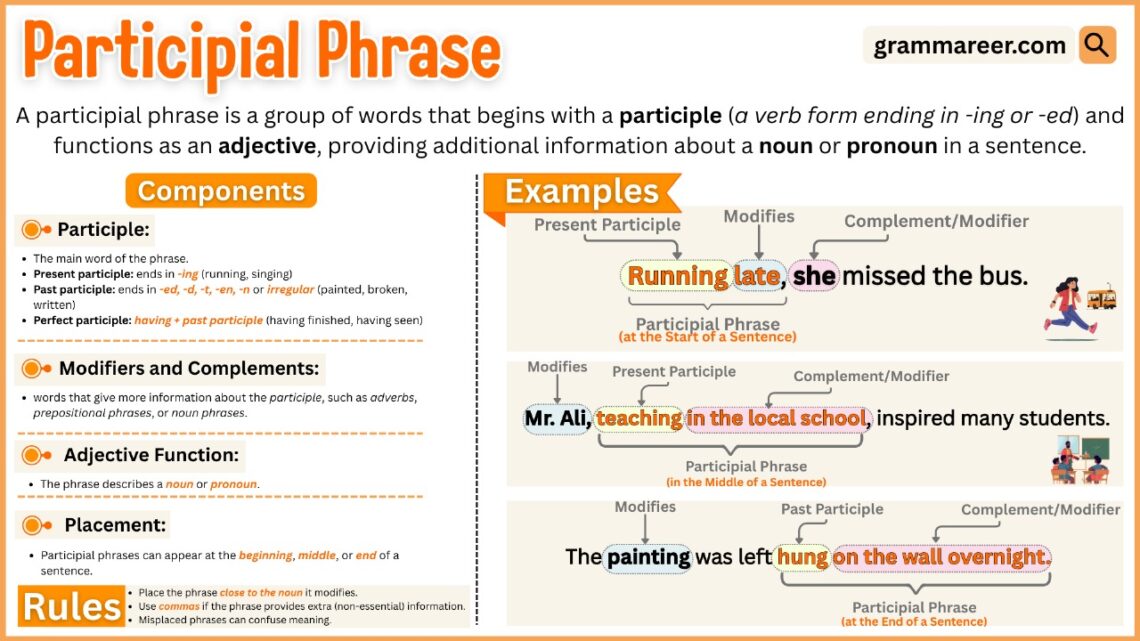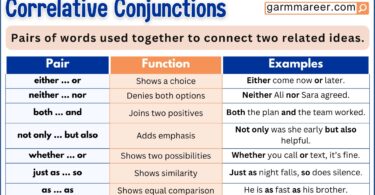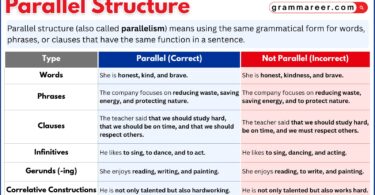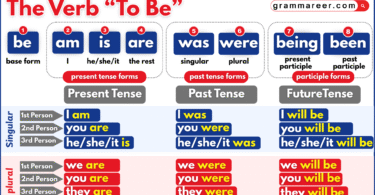While learning tenses, you probably noticed verbs changing into different forms, and one of those forms is called a participle. But here’s something interesting—did you know participles can also be part of a bigger structure called a participle phrase?
Wondering what that actually means and how it works? Don’t worry, this article will walk you through what a participle phrase is, how it’s formed, and how you can use it in sentences with clear examples.
Table of Contents
Definition of Participle Phrases:
A participle phrase is a group of words that begins with a participle. A participle is just a verb form ending in -ing (present participle) or -ed/-en (past participle). These phrases work like adjectives or adverbs, giving extra information about a noun or verb in a sentence.
For example:
- Running fast, the boy caught the bus.
- Here, running fast is a participle phrase describing the boy.
Dictionaries also explain it simply: a participle is a verb form that looks like a verb but often works like an adjective.
By learning participle phrases, you can make your sentences more clear, detailed, and interesting.
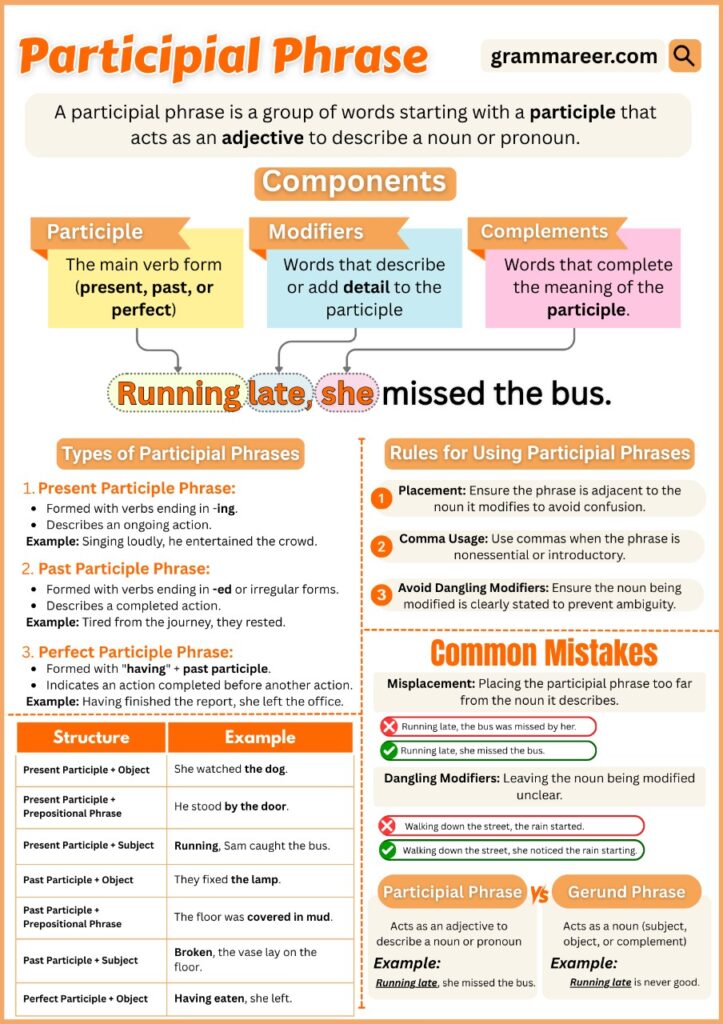
How to Form and Use Participle Phrases?
A participle phrase usually acts like an adjective in a sentence. You can put it at the beginning, middle, or end of a sentence, but the punctuation changes depending on its position.
- At the start → put a comma after the phrase.
- Example: Running quickly, the boy caught the bus.
- In the middle → use commas before and after the phrase.
- Example: The car, damaged in the accident, was taken to the workshop.
- At the end → usually no comma is needed.
- Example: She bought a dress made of silk.
If the phrase gives extra information about the subject, it can go at the start or in the middle. If it describes the object, place it right after the object without a comma. And if it works like an adverb giving more details about the action, put it at the end with a comma.
- Example (object, no comma): He read the book written by his teacher.
- Example (adverb, with comma): She smiled at me, feeling happy.
How to Identify a Participle Phrase in a Sentence
A participle phrase is easy to spot once you know the steps. Here’s how to identify one:
- Look for a participle – an -ing word (running, smiling) or a past form (broken, written, painted).
- Check if it has extra words – participle phrases often include objects, modifiers, or prepositional phrases.
- Running quickly down the street
- Broken by the storm
- See what it describes – the phrase usually modifies a noun or verb, not standing alone as the main action.
- Test the sentence without it – if the sentence is still grammatically correct, you’ve found a participle phrase.
Example:
- Sentence: The car, parked outside the house, belongs to my uncle.
- Step 1: parked = past participle.
- Step 2: parked outside the house = participle phrase.
- Step 3: It describes car.
- Step 4: Without it → The car belongs to my uncle.
Participle Phrases with Present and Past Participles
When we talk about participle phrases, we’re really looking at how present participles (-ing words) and past participles (-ed, -en, -t, etc.) can be used together with other words to add detail to a sentence.
- A present participle phrase shows an action happening at the same time as the main verb.
- Example: Running down the street, the boy waved at his friend.
(Here, running down the street tells us more about the boy.)
- Example: Running down the street, the boy waved at his friend.
- A past participle phrase usually shows something already completed or affected by an action.
- Example: Broken by the storm, the fence needed repair.
(Here, broken by the storm gives extra information about the fence.)
- Example: Broken by the storm, the fence needed repair.
Both types of participle phrases work like adjectives, but they add a layer of description that makes writing richer and more interesting.
Perfect Participles
Sometimes you’ll see participle phrases that begin with “having” + past participle. These are called perfect participles.
Example:
- having seen, having taken, having read
They are not a completely new type of participle but a combination of a present participle (having) and a *past participle.
Example:
- Having read your book, I now understand your position.
- Having signed the document, Jason felt relieved.
Dangling participles
A very common mistake people make with participial phrases is the dangling participle. A dangling participle happens when a participle (or participle phrase) is placed in a sentence in a way that it seems to describe the wrong word — or nothing at all. This makes the sentence confusing or even funny.
Example:
- ❌ Driving to work, the car broke down.
- (Wrong – looks like the car was driving.)
- ✔ Driving to work, John had his car break down.
- (Right – John is the subject.)
The fix is simple: put the subject right after the phrase.
Participle Phrase vs Gerund Phrase:
It’s easy to mix up participle phrases and gerund phrases because both use verbs ending in -ing. To make it clear, here’s how they differ:
| Participle phrase– Uses a present or past participle. Works like an adjective. Adds extra information, but the sentence still makes sense without it. | Gerund phrase – Uses a gerund (-ing form). Works like a noun. It’s the subject or object, so the sentence doesn’t work without it. |
| Example: She spent her day sitting by the beach and watching the waves. | Example: Sitting by the beach and watching the waves is her favorite thing to do. |
Examples of Sentences Using Participle Phrases
Here’s how participle phrases work in different positions in a sentence.
1. Sentences with Participle Phrases at the Beginning
- Running late for class, Ayesha skipped breakfast.
- Excited, the kids rushed to open their presents.
- Having finished the project, Ali finally relaxed.
2. Sentences with Participle Phrases in the Middle
- The Eiffel Tower, glowing at night, attracts millions of visitors.
- My brother, inspired by his teacher, started painting again.
- The old library, filled with dusty books, smelled of history.
3. Sentences with Participle Phrases at the End
- Sara watched the puppy playing in the garden.
- We saw a rainbow spreading across the sky.
- The teacher smiled, pleased with her students’ progress.
Why Participle Phrases are important?
Participle phrases might look tricky at first, but they’re really useful. They can make your sentences shorter, more interesting, and even help you say more in less space.
At the same time, if you don’t use them carefully, they can cause mistakes. Let’s break it down in the simplest way possible.
Reason 1: They Help You Say More in Fewer Words
Participle phrases can pack extra details into one sentence instead of writing two or three.
- ✔ Communicating clearly with everyone, Ali kept the team on track.
- ✔ Having shown great teamwork, Ali became a role model for others.
See how both examples give you two ideas about John in just one sentence? That’s the power of participle phrases.
Reason 2: Punctuation Matters
Where you put commas makes a big difference with participle phrases.
- At the beginning of a sentence → add a comma after the phrase.
- ✔ Removing his glasses, the professor shook his head.
- Right after the noun → usually no comma.
- ✔ The cake baked yesterday was delicious.
- If it’s extra information (not essential) → use commas.
- ✔ The yellow Ferrari, unregistered and stolen, was used as a getaway car.
- At the end of a sentence (not right after the noun) → use a comma.
- ✔ The boys loved their boxing gloves, wearing them even to bed.
Reason 3: Watch Out for Dangling Participles
This mistake happens when the phrase has no clear subject.
- ❌ Having taken the medicine, the illness was cured.
- (Who took the medicine? Not clear.)
- ✔ Having taken the medicine, Sarah felt better.
- (Now we know who did it.)
Always make sure the phrase clearly connects to the right subject.
Reason 4: Avoid Misplaced Modifiers
This happens when the phrase is too far from the word it’s supposed to describe, making the sentence confusing.
- ❌ The meerkats are afraid of the eagles, scurrying from burrow to burrow.
- (Sounds like the eagles are running!)
- ✔ Scurrying from burrow to burrow, the meerkats are afraid of the eagles.
The rule: keep your participle phrase right next to the noun it describes.
FAQs
A participle phrase is a group of words built around a participle (present or past). It works like an adjective or adverb in a sentence, adding extra detail about a noun or action.
You can place a participle phrase at the beginning, middle, or end of a sentence.
If it acts like an adjective, it should stay close to the subject or object it describes.
At the beginning, always add a comma after the phrase.
In the middle, put the phrase between commas.
At the end, no comma is needed if it simply adds info about the action or object.
• Running fast, Ali reached the bus.
• Smiling brightly, Sara greeted her teacher.
• The boy, playing football, is my brother.
• The cake, baked by my mom, tastes amazing.
• I saw a cat sleeping on the roof.
• She held a flower picked from the garden.
Final Thought
As we learned, participle phrases are little word groups that help us describe and add detail to our sentences. They can sit at the beginning, middle, or end of a sentence, but the key is to make sure they connect to the right subject so your meaning stays clear. Used correctly, they make writing smoother and more interesting, without making sentences feel too heavy.
You May Also Like
What is Noun Phrase?
What are Prepositional Phrases?
Phrasal Verbs in English

